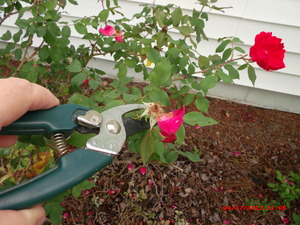Abelia, also commonly referred to as Glossy Abelia, is a member of the Caprifoliaceae or honeysuckle family. They are a native tree of China, Japan, the Himalayas and Mexico. More technically, it is a hybrid cross between Chinese Abelia and A. uniflora. This small tree is a wonderful container plant because it grows only 3 to 6 feet tall. It can also be planted in the soil where it will spread as a ground-cover. Depending on the variety chosen, this plant is either a deciduous or an evergreen shrub. It is hardy in U.S. Department of Agriculture zones 6 through 9.
The lightly scented flowers come in a variety of colors like lavender-pink, pale rose, red, or bi-colored. The Abelia starts blooming in mid-summer and continues to mid-fall.
If you would like to include this tree in your landscape, or patio area, you could go out and buy one at the nursery. But why spend money when you can easily propagate the Abelia on your own.
Before you gather the cuttings, take along a wet paper towel stored inside a plastic bag. This will keep the cuttings hydrated until you get back home to plant them.
Gather the Stems
Early in the spring, examine the Abelia tree to find new or softwood stems. You can determine if the stems are new or soft wood by bending them and looking at them. New growth is a different color than old growth and when you bend the stem, it is pliable. You shouldn’t hear any snapping, popping or breaking. Cut the stems at 6 inches or longer. Make your cut right below a leaf node.
Remove all the leaves except for the top two or four. If all the leaves are left on the stem, the plant will put its energy into sustaining the leaves, instead of forming roots. Wrap the cut end of the stem in the wet paper towel and place them in the plastic bag. Close the bag to keep in moisture.
Fill Pots
Gather several 2-inch pots. You will need one pot per cutting. You can also use disposable cups, but make sure you punch drainage holes in the bottom. Fill the pots or cups with moistened well-draining potting soil. To moisten the soil, cover the worktable with a plastic tablecloth or tarp. Spread some potting soil over the top and sprinkle a little water over it. Mix the water in to the soil with your hands, until the soil is moistened. Don’t add too much water or it will be too soggy and the cuttings will rot.
Planting Softwood Stems
Take the cuttings out of the bag. Insert the cut end of the stem into the soil. Firm the potting soil around the stem to help hold it upright. Place the pots in a tray or old cake pan, if you have many cuttings. This makes carrying them easier, and it helps to hold the pots upright.
Cover with Plastic
Place the pots in a plastic bag and close the top of the bag. Find a warm location with a bright window to place your cuttings. Do not place them in direct sunlight because it will be too hot inside the plastic bag.
Water
Check the cuttings for moisture. If the soil becomes dry, wet it by pouring a little water over the soil. Again, don’t over-water or the stems will rot.
New Growth
Watch for signs of new growth. It usually takes one to two months for the cuttings to root. Gently pull on the cutting. If it pulls easily, then the roots have not yet formed and you’ll need to keep it in the plastic bag.
Transplant
Transplant to a bigger pot after the roots have formed. Set outside when all danger of frost is past.
Sources:
Home and Garden Ideas: How to Care for Glossy Abelia
Royal Horticultural Society: Abelia x grandiflora AGM
“American Horticultural Society A to Z Encyclopedia of Garden Plants”; Christopher Brickell; 2004
“National Garden Book”; Sunset Books; 1997



